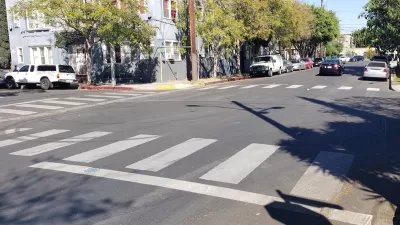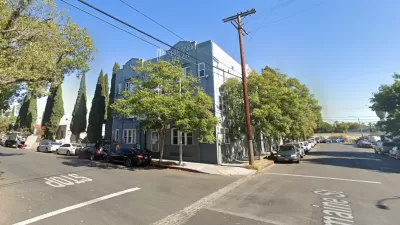Though projects tend to be hyper-local and temporary, Do It Yourself, Tactical, or Guerrilla Urbanism is an endorsement of the top-down planning model, rather than a repudiation.

In a lot of ways, I sympathize with so-called "Do It Yourself" (DIY) urbanism and planning. It helps place smaller projects at the front of the line for implementation, much different than the lengthy process required to move equally minor projects (let alone big projects) through the bureaucracy of civil government. Of course, the funny thing about my sympathy for DIY planning is that, while it touts itself as a rebuttal of the traditional top-down planning process, DIY is fundamentally an endorsement of the top-down planning process.
Where DIY comes from
Having now spent several years in a mix of public sector internships during graduate school and private sector jobs, coupled with a pragmatic personality type, I tend to favor a top-down planning model. Top-down planning is largely defined as debating and deciding planning priorities at a higher level of government or central body, such as a regional planning agency. But most importantly, those decisions or priorities are considered binding once determined, and it is the responsibility of lower-level jurisdictions to conform to the established priorities. For example, in a top-down model, if a regional agency sets a number of housing units that must be built in every city to meet projected demand, each city is required to permit that number of units, if not more, otherwise risk losing support from the agency (such as transportation funding).
Critiques of top-down planning can and have been discussed, including what I call the "ignorance of the individual" in traditional Rational Planning Theory. That is, when planning separates individual from collective rationality the same way as when laws require all drivers and passengers to wear seatbelts (rather than just rely on the individual's rational desire to stay alive). These critiques have led to a backlash against top-down planning, including the rise of community based planning, or participatory planning, where smaller geographic planning priorities are often generated at the community level, rather than larger priorities at a higher level. Higher levels of government must then try to envelope these local priorities within their planning priorities.
As I've argued in the past, the length and lassitude of the American urban planning model can be attributed to the competing implementation of both Rational and Participatory Planning theories. Like two major political parties slugging it out for control of government reigns, it's natural that a third-way would emerge.
Advocates of DIY Planning, or any its derivations, such as "Tactical" or "Guerilla" planning, argue that their process goes beyond participatory planning. Rather than seek public input, DIY planners go a step further by empowering residents to make change themselves without engaging in the traditional community planning process. Individual projects are resident-generated and often conducted without the formal approval of city planning departments or other government agencies. They produce small projects that tend to be low-budget and temporary, but have a legitimate chance to become permanent. Whether it's a parklet taking over a parking space, sidewalk garden or painting a mid-block crossing where common sense says one should exist, advocates argue that they have added to a community. However, this type of planning is not only an endorsement of top-down planning, but at its extreme, is an endorsement of unilateral decision making in planning.
DIY requires top-down decision making model
At its base, DIY can seem like the tool advocates argue for; i.e., it advances beyond simple community participation because the process is spearheaded by a hyper-local community, if not a sole individual. But unlike the traditional participatory model of planning, DIY does not require community input. In fact, it gladly pushes that aside. In Tactical Urbanism Vol. 1, the authors decry that "residents are asked to react to proposals that are often conceived for interests disconnected from their own, and at a scale for which they have little control."
DIY only requires a single or very small group of individuals to make a decision for their community. Their community may be small, such as a neighborhood street or a small commercial strip as examples, but nevertheless, DIY implements a hyper-local preference with no outside consult. You may think that missing community input is of little concern because the scale is so small, but we cannot escape the process DIY advocates employ. A follower of the DIY paradigm unilaterally decides what should or should not be implemented.
I also reject the idea that DIY incudes under its umbrella the temporary projects enacted by municipal governments. Can it truly be DIY if operated by a bureaucratic agency or department? Cities have been engaged in these types of street closures or other so-called reclamation of space events for some time. In the same Tactical Urbanism Vol. 1, the authors list Street Fairs (page 12) as an example of good tactical urbanism. Great projects, for sure, but street fairs have been a staple of American urbanism for centuries. Is the difference now only location, frequency, and $7 artisan vegan dogs? Whether this is a difference or not, the process for permitting a street fair remains the same. It does not happen on a whim, and more than one party is brought in to the conversation.
Street fairs notwithstanding, the bulk of DIY planning may be found in simple acts, but the same criticism of rational planning theory can still be applied to the DIY Planning process. Paradoxically, by leaning so heavily on the preferences of a single or small group of individuals, DIY too suffers from the "Ignorance of the Individual" by ignoring the preferences of others. Is the improvement that he or she wants the same improvement that others want? Would they rather spend the same amount of money or resources, however small, on something else? DIY relies heavily on the passions and wants of a single or small group of individuals who do not waver in the presence of outside pressures. As advocates would argue, they have removed those pesky community input meetings in the name of efficiency and action, moving the top of the top-down model to the hyper-local level.
I appreciate the sentiment of DIY advocates and I am not making the moral judgment on their efforts in either direction. They, like me, are often frustrated by the current planning model. In the sentences preceding the above Tactical Urbanism Vol. 1 quote, the authors clearly state that "in the pursuit of progress, citizens are typically invited to engage in a process that is fundamentally broken." Clearly, advocates of DIY can sense that something is flawed with the overall process—likely sensing the struggle between the two leading planning theories. But to advocate for DIY Planning, even if it's limited to small and temporary projects, is to argue that efficiency and action are paramount to the overall urban planning process, and limiting broader community input is the solution. If these are the goals we all share, I have a top-down planning model I would like to re-introduce to everyone.

Trump Administration Could Effectively End Housing Voucher Program
Federal officials are eyeing major cuts to the Section 8 program that helps millions of low-income households pay rent.

Planetizen Federal Action Tracker
A weekly monitor of how Trump’s orders and actions are impacting planners and planning in America.

Ken Jennings Launches Transit Web Series
The Jeopardy champ wants you to ride public transit.

Rebuilding Smarter: How LA County Is Guiding Fire-Ravaged Communities Toward Resilience
Los Angeles County is leading a coordinated effort to help fire-impacted communities rebuild with resilience by providing recovery resources, promoting fire-wise design, and aligning reconstruction with broader sustainability and climate goals.

When Borders Blur: Regional Collaboration in Action
As regional challenges outgrow city boundaries, “When Borders Blur” explores how cross-jurisdictional collaboration can drive smarter, more resilient urban planning, sharing real-world lessons from thriving partnerships across North America.

Philadelphia Is Expanding its Network of Roundabouts
Roundabouts are widely shown to decrease traffic speed, reduce congestion, and improve efficiency.
Urban Design for Planners 1: Software Tools
This six-course series explores essential urban design concepts using open source software and equips planners with the tools they need to participate fully in the urban design process.
Planning for Universal Design
Learn the tools for implementing Universal Design in planning regulations.
Ada County Highway District
Clanton & Associates, Inc.
Jessamine County Fiscal Court
Institute for Housing and Urban Development Studies (IHS)
City of Grandview
Harvard GSD Executive Education
Toledo-Lucas County Plan Commissions
Salt Lake City
NYU Wagner Graduate School of Public Service





























